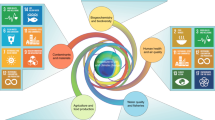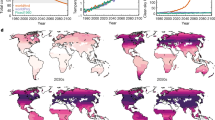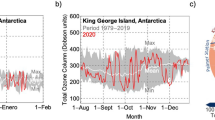Abstract
DEPLETION of the ozone layer has been observed on a global scale1, and is probably related to halocarbon emissions. Ozone depletion increases the biologically harmful solar ultraviolet radiation reaching the surface of the Earth, which leads to a variety of adverse effects, including an increase in the incidence of skin cancer. The 1985 Vienna Convention provided the framework for international restrictions on the production of ozone-depleting substances. The consequences of such restrictions have not yet been assessed in terms of effects avoided. Here we present a new method of estimating future excess skin cancer risks which is used to compare effects of a 'no restrictions' scenario with two restrictive scenarios specified under the Vienna Convention: the Montreal Protocol, and the much stricter Copenhagen Amendments. The no-restrictions and Montreal Protocol scenarios produce a runaway increase in skin cancer incidence, up to a quadrupling and doubling, respectively, by the year 2100. The Copenhagen Amendments scenario leads to an ozone minimum around the year 2000, and a peak relative increase in incidence of skin cancer of almost 10% occurring 60 years later. These results demonstrate the importance of the international measures agreed upon under the Vienna Convention.
This is a preview of subscription content, access via your institution
Access options
Subscribe to this journal
Receive 51 print issues and online access
$199.00 per year
only $3.90 per issue
Buy this article
- Purchase on Springer Link
- Instant access to full article PDF
Prices may be subject to local taxes which are calculated during checkout
Similar content being viewed by others
References
World Meteorological Organization in Scientific Assessment of Ozone Depletion: 1994 Global Ozone Research and Monitoring Project WMO Rep. 37 (WMO, Geneva, 1995).
Madronich, S. & de Gruijl, F. R. Nature 366, 23 (1993).
Kricker, A., Armstrong, B. K. & McMichael, A. J. Nature 368, 594 (1994).
Holman, C. D. J. & Armstrong, B. K. J. Natl Cancer Inst. 73, 75–82 (1984).
Scotto, J. & Fears, T. R. Incidence in Non-melanoma Skin Cancer in the United States NIH Publication 82–2433 (National Institutes of Health, Washington DC, 1981).
Health Council of the Netherlands UV Radiation from Sunlight, The Hague 1994/05E (Health Council of the Netherlands, The Hague, 1994).
Daniel, J. S., Solomon, S. & Albritton, D. L. J. Geophys. Res. D 100, 1271–1285 (1995).
World Meteorological Organization in Scientific Assessment of Ozone Depletion: 1991 Global Ozone Research and Monitoring Project WMO Rep. 25 (WMO, Geneva, 1992).
Velders, G. J. M. Scenario Study of the Effects of CFC, HCFC and HFC Emissions on Stratospheric Ozone Report 722201006 (RIVM, Bilthoven, the Netherlands, 1995).
Kerr, R. A. Science 270, 376 (1995).
McKenzie, R. L. et al. in Global Ozone Research and Monitoring Project WMO Rep. 37 Chapter 9 (WMO, Geneva, 1995).
Slaper, H., Reinen, H. A. J. M., Blumthaler, M., Huber, M. & Kuik, F. Geophys. Res. Lett. 22, 2721–2724 (1995).
Bordewijk, J. A., Slaper, H., Reinen, H. A. J. M. & Schlamann, E. Geophys. Res. Lett. 22, 2151–2154 (1995).
De Gruijl, F. R. et al. Cancer Res. 53, 53–60 (1993).
De Gruijl, F. R. & van der Leun, J. C. Health Phys. 67, 319–325 (1994).
Slaper, H., Schothorst, A. A. & van der Leun, J. C. Photodermatology 3, 271–283 (1986).
De Gruijl, F. R. & Forbes, P. D. BioEssays 17, 651–660 (1995).
Vitasa, B. C. et al. Cancer 65, 2611–2617 (1990).
Gallagher, R. P. et al. Arch. Dermatol. 131, 157–163 (1995).
Slaper, H., den Elzen, M. G. J., van der Woerd, H. J. & de Greef, J. in Ozone Depletion and Skin Cancer Incidence: An Integrated Modeling Approach Report 749202001 (RIVM, Bilthoven, the Netherlands, 1992).
Setlow, R. B., Grist, E., Thompson, K. & Woodhead, A. Proc. Natl Acad. Sci. USA 90, 6666–6670 (1993).
Lubin, D. & Jensen, E. H. Nature 377, 710–713 (1995).
Alternative Fluorocarbon Environmental Acceptability Study Production, Sales and Atmospheric Release of Fluorocarbons through 1992 (Grant Thomton, Washington DC, 1993).
de Winter, R. in Depletion and Natural Variability of the Ozone Layer from TOMS Observation Report 722201005 (RIVM, Bilthoven, the Netherlands, 1995).
Ziegler, A. et al. Proc. Natl Acad. Sci. USA 90, 4216–4220 (1993).
Berg, R. J. W. et al. Proc. Natl Acad. Sci. USA 93, 274–278 (1996).
Slaper, H. thesis, Utrecht University (1987).
Longstreth, J. D. (ed.) Ultraviolet Radiation and Melanoma UA-EPA 400/1-87/001D (US Environmental Protection Agency, Washington DC, 1987).
Author information
Authors and Affiliations
Rights and permissions
About this article
Cite this article
Slaper, H., Velders, G., Daniel, J. et al. Estimates of ozone depletion and skin cancer incidence to examine the Vienna Convention achievements. Nature 384, 256–258 (1996). https://doi.org/10.1038/384256a0
Received:
Accepted:
Issue Date:
DOI: https://doi.org/10.1038/384256a0
This article is cited by
-
Catalytic hydrolysis of monochlorodifluoromethane over ZnO/ZrO2 catalysts at low temperatures
Environmental Science and Pollution Research (2024)
-
Impact of a gravity wave process on the upper stratospheric ozone valley on the Qinghai-Tibetan Plateau
Theoretical and Applied Climatology (2024)
-
Quantifying contributions of ozone changes to global and arctic warming during the second half of the twentieth century
Climate Dynamics (2023)
-
Knowledge and Attitudes of Cypriots on Melanoma Prevention: Is there a Public Health Concern?
BMC Public Health (2022)
-
Antarctic ozone hole modifies iodine geochemistry on the Antarctic Plateau
Nature Communications (2021)
Comments
By submitting a comment you agree to abide by our Terms and Community Guidelines. If you find something abusive or that does not comply with our terms or guidelines please flag it as inappropriate.



